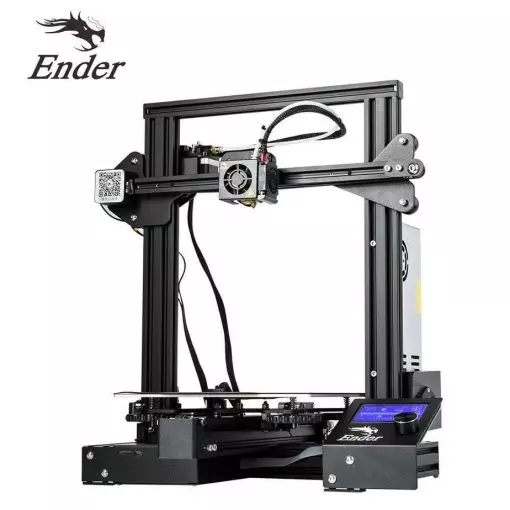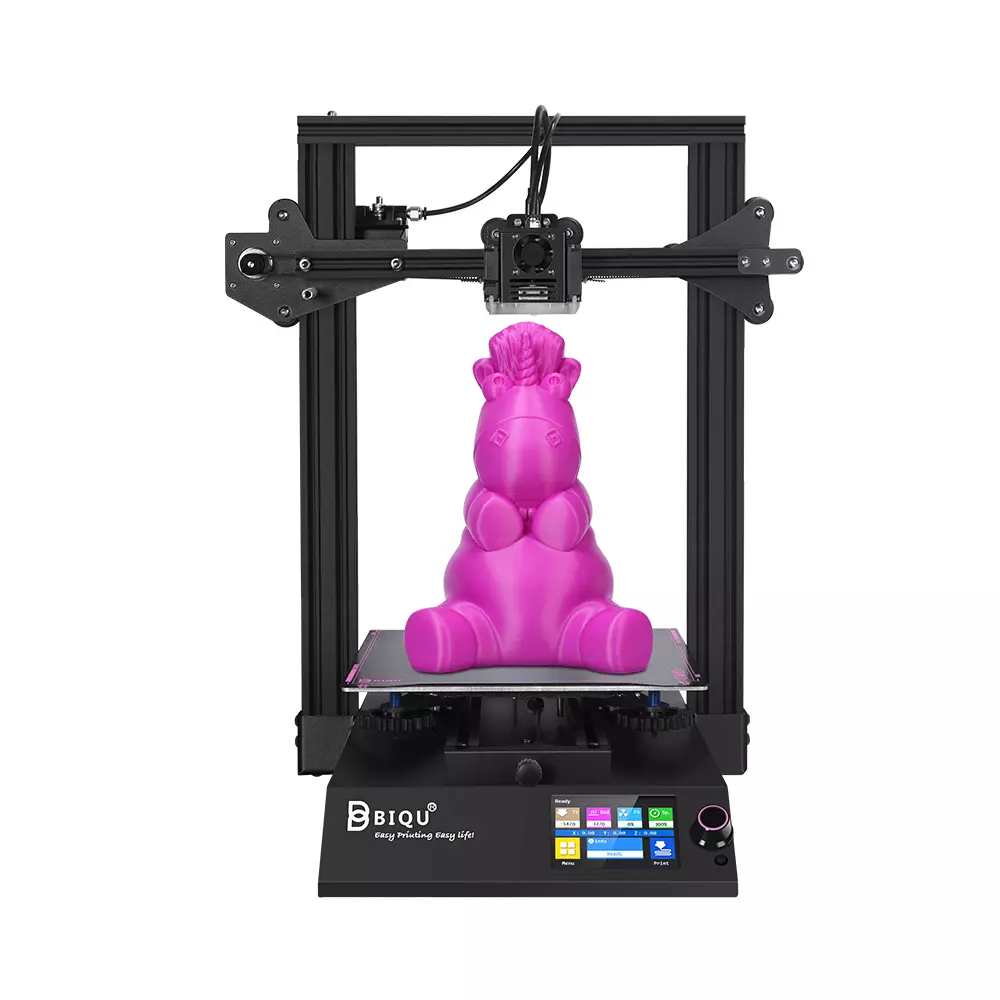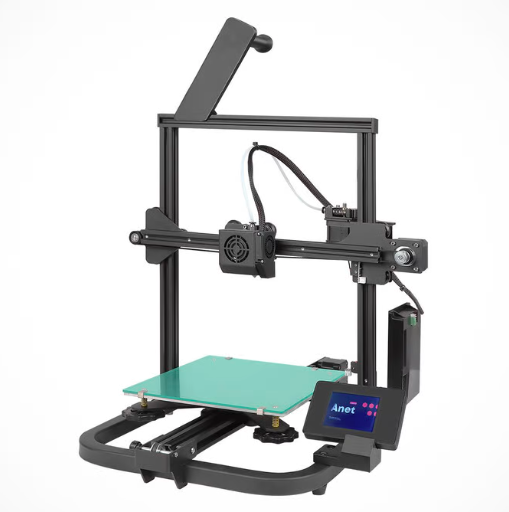Compare Ender 3 vs BIQU B1 vs A8 V2
Comparison between the best 3D printers
Choose the best 3D printer at the best price. The cheapest 3D printers are here.
Buy a 3D printer here with 3D Fila.
 |
 |
 |
|
| Model | Ender 3[BUY Ender 3] |
BIQU B1 |
A8 V2 |
| Printing Material | Filament | Filament | Filament |
| Estimated price | $210,00 | $269,00 | $129,00 |
| Fabricante | Creality 3D | BigTreeTech | Anet |
| Release Year | 2018 | 2020 | 2021 |
| Print Volume [mm] | 220x220x250 | 235x235x270 | 220x220x250 |
| Printer Size [mm] | 440x440x465 | 412x402x492 | 428x441x486 |
| Weight [kg] | 6,62 | 8,00 | 6,2 |
| Power Loss Recovery | NO | YES | NO |
| Enclosed printer | NO | NO | NO |
| Bed Leveling | Manual | Manual | Manual |
| Filament End Sensor | NO | YES | NO |
| Bed type | Heated | Heated | |
| Power supply system | Bowden | Bowden | Bowden |
| Standard nozzle | 0,4 | 0,4 | 0,4 |
| Maximum Nozzle Temperature [°C] | 255 | 250 | 230 |
| Maximum Bed Temperature [°C] | 110 | 100 | |
| Maximum printing speed [mm/s] | 180 | 100 | 150 |
| Filament holder | YES | YES | YES |
| Camera for supervision | NO | NO | NO |
| Recommended filaments | PLA, TPU, ABS, PETG | PLA, TPU, ABS, PETG | PLA |
| Recommended slicers | Cura, Simplify, Slic3r | Cura, Simplify, Slic3r | Cura, Simplify, Slic3r, IdeaMaker |
| Maximum Resolution [mm] | 0,1 | 0,1 | 0,1 |
| Processor | 8 bits | 32 Bits BTT SKR V 1.4 | |
| Display | Mono | Touchscreen TFT 3,5'' | Display touchscreen 2,8'' |
| Power Supply | 24V / 270W | 24V / 360W | 110/220V / 250W |
| Connectivity | SD / USB | SD / USB | SD / USB |
| Operating systems | Windows, Mac, Linux | Windows, Mac, Linux | Windows, Mac, Linux |
| Date of registration in the system | 2021-04-13 | 2021-04-14 | 2022-11-10 |
| Release date | 2018 | 2020 | 2021 |
| Extra features | The Ender 3 V1 is a DIY assembly 3D printer, a sales leader since 2017, standing out for its cost-benefit. With a wide printing capacity, it has a CNC machined structure for precision and stability. It offers high-precision prints with low noise, thanks to its innovative V-profile and pulleys. It has a self-adhesive magnetic platform for easy removal of models and excellent adhesion. The Ender 3 heats up quickly, reaching 100°C in 5 minutes, ideal for agile prints. It includes protection against power failures, allowing you to resume printing after interruptions, saving time and material. | The BIQU B1 is an advanced 3D printer with a silent 32-bit BTT SKR V1.4 motherboard and ARM Cortex-M3 CPU, offering DIY interfaces (I2C, SPI, WiFi) and dual Z-axis. Its dual BTT B1 TFT35 V3.0 operating system allows real-time monitoring and multiple printing modes, including G-code visualization effects. It stands out for its BIQU SSS (Super Spring Steel), ensuring easy model adhesion and simplified removal, with the possibility of using it on both sides. It includes a filament sensor, automatically pausing printing in case of filament breakage. The multicolored RGB lights integrated into the hotend allow you to view the printing status even at night. Additional notes include the need for a BIQU-specific Type-C cable and extra interfaces for smart filament sensor and BL Touch. | The Anet A8 V2 is a Cartesian-XZ type 3D printer with a build volume of 220 x 220 x 250 mm, Ender 3 design and V-slot assembly. It has a 32-bit motherboard and touchscreen interface, promising ease of use. It uses open source firmware and has thermal failure protection. It stands out for its cable organization and the absence of a heated bed, focusing on energy savings and PLA printing. It comes with an external power adapter, aiming at greater safety, especially for beginners and educational use. |
| Support for multiple colors and materials (AMS and CFS) | NO | NO | NO |
Notes * |
|||
| Cost-benefit | 6 / 10 | 7 / 10 | 6 / 10 |
| Hardware | 0.5 / 10 | 2 / 10 | 0.6 / 10 |
| Screen | . | . | . |
| Print volume | 3 / 10 | 3 / 10 | 3 / 10 |
| Performance | 1 / 10 | 1 / 10 | 1 / 10 |
| [BUY Ender 3] |
Conclusion |
| In conclusion, when comparing the Ender 3, BIQU B1, and A8 V2, several factors influence choosing the best 3D printer for different needs and budgets. The **Ender 3** stands out as a cost-effective and reliable option, known for its stability and print quality. Its ability to resume printing after power failures and rapid heating of the bed make it suitable for users looking for efficiency and reliability in their prints. However, it lacks advanced features such as a filament sensor and is limited to manual bed leveling. The **BIQU B1** offers advanced features like a silent 32-bit motherboard, dual Z-axis, and a filament sensor, making it a strong contender for users who prioritize high-tech solutions and ease of use. Its larger print volume and enhanced operating system can lead to better overall performance, especially for users who may want to experiment with more complex projects. The **A8 V2**, while the most affordable of the three, focuses on basic features and energy efficiency, catering mostly to beginners and educational purposes. It does not support a heated bed, which limits its filament compatibility primarily to PLA, and lacks some modern conveniences found in the other models. Ultimately, the choice between these printers should consider the user's experience level, budget, and specific printing requirements. For those seeking a balance of performance and price, the Ender 3 is an excellent option. Users who value advanced features may prefer the BIQU B1, while beginners can find a suitable entry point with the A8 V2, despite its limitations. |

